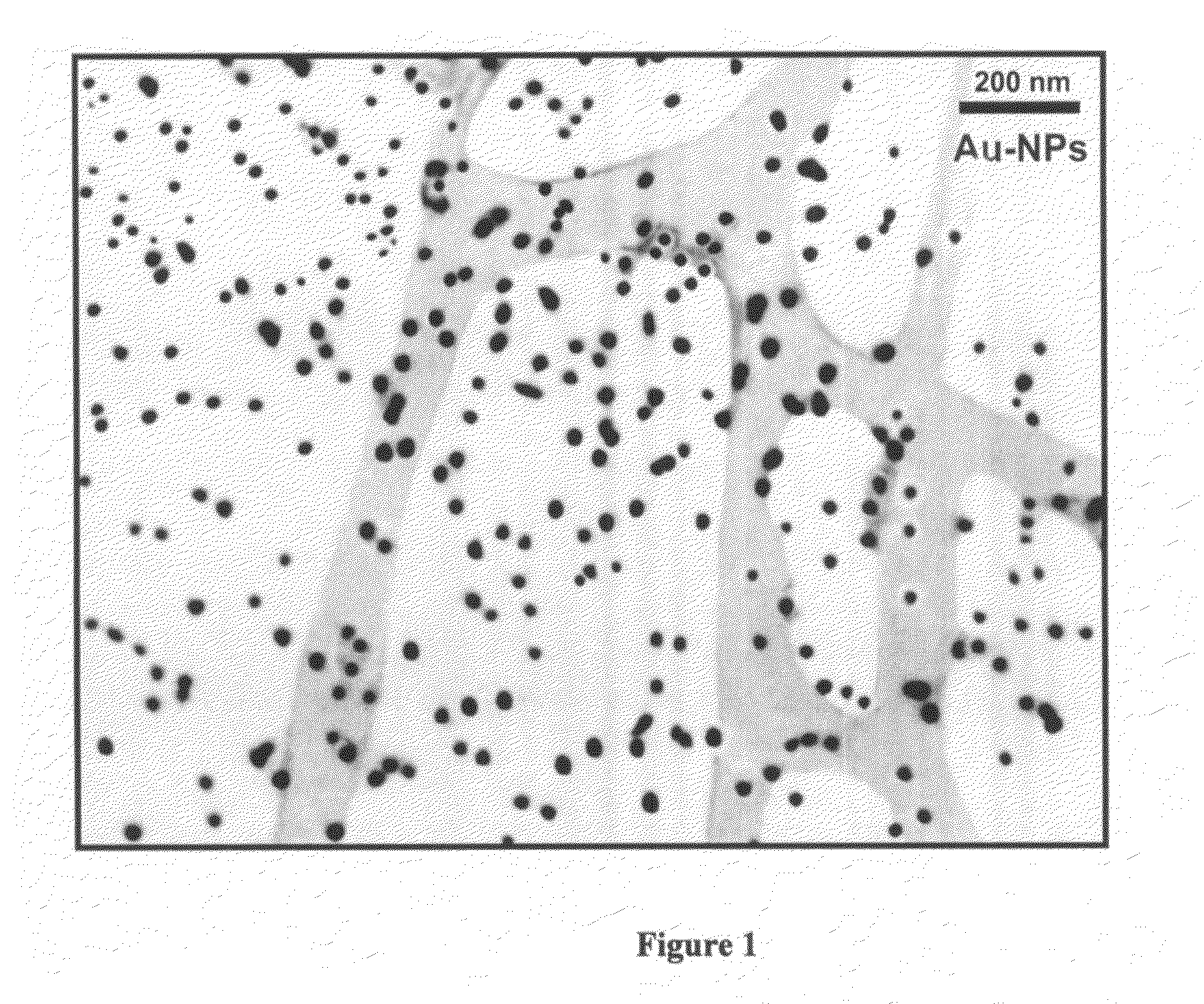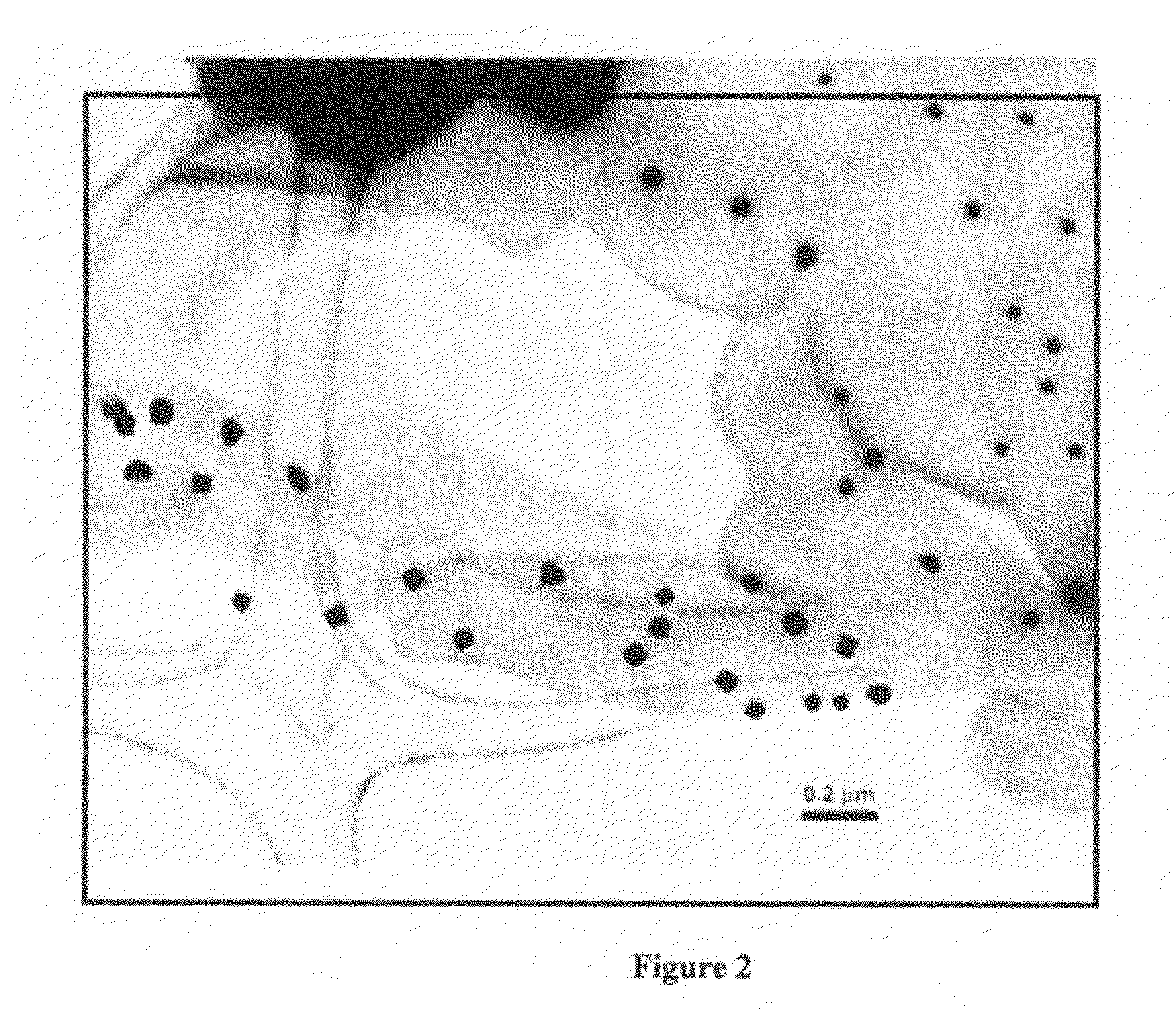In-situ nanoparticle formation in polymer clearcoats
a technology of polymer clearcoat and in-situ nanoparticles, which is applied in the direction of silicon oxides, instruments, photosensitive materials, etc., can solve the problems of complex production of nanopowders, nanopowders exhibit a tendency to agglomerate, and form larger particles
- Summary
- Abstract
- Description
- Claims
- Application Information
AI Technical Summary
Benefits of technology
Problems solved by technology
Method used
Image
Examples
example 1
[0118]In this example gold nanoparticles are generated in-situ in the polymer clear coat layer during curing or baling at a temperature in the range of about 100-200° C. This temperature range is based on the manufacturer's recommended ideal curing temperature for the clear coat formulation of 140° C.
[0119]Hydrogen tetrachloroaurate, HAuCl4, is a nanoparticle precursor material dissolved in a clear coat resin composition in this example. HAuCl4, is dissolved in 10 milliliters of curable clear coat resin composition by stirring for 5-10 minutes to achieve a concentration of 0.002M of the Au nanoparticle precursor material.
[0120]Samples of resulting curable clear coat resin material including the gold nanoparticle precursor are applied as a thin film approximately 100 microns by spray coating a substrate with the curable clear coat resin material including the gold nanoparticle precursor and curing by heating with a heat gun or in a convection oven at a temperature in the range of abo...
example 2
[0131]Color intensity increases with layer thickness. One, two, three, four or five layers of a curable clear coat resin composition including the gold nanoparticle precursor hydrogen tetrachloroaurate at a concentration of 0.002 M are applied to a substrate to demonstrate effects of an increase in thickness of layered material. In this example, a five layer material is five times thicker than a one layer material. Even after multiple layering has been applied to a glass surface, the transparency of the coating does not noticeably decrease with increasing number of layers and total thickness of the cured layered material. The color intensifies with increasing number of layers and total thickness of the layered material because there are more Au—NPs available in the path of incoming light which results in enhanced plasmon-induced coloration.
example 3
[0132]Table 1 illustrates amounts of particular gold-, selenium- and tin-containing precursors dissolved in a curable clear coat composition. A precursor of gold nanoparticles in the form of hydrogen tetrachloroaurate, HAuCl4, is dissolved in 10 milliliters of curable clear coat resin composition by stirring for 5-10 minutes to achieve a concentration of 0.002M Au nanoparticle precursor, HAuCl4, in curable clear coat resin, CC. Fine powders of SeCl4 and SnCl2 are added and stirred until dissolved in the curable clear coat resin composition. SeCl4 and SnCl2 are added in various amounts ranging from 0.001-0.010 grams for SeCl4 and 0.001-0.100 grams for SnCl2.
TABLE 1AdditionalMetalAdditional MetalNanoparticleNanoparticleConcentration ofPrecursorPrecursorSample IDAu Precursor in CCSeCl4SnCl210.002 M0.001 g0.001 g20.002 M0.005 g0.001 g30.002 M0.010 g0.001 g40.002 M0.001 g0.010 g50.002 M0.005 g0.010 g60.002 M0.010 g0.010 g70.002 M0.001 g0.100 g80.002 M0.005 g0.100 g90.002 M0.010 g0.100 g
[...
PUM
| Property | Measurement | Unit |
|---|---|---|
| particle size | aaaaa | aaaaa |
| transparent | aaaaa | aaaaa |
| particle size | aaaaa | aaaaa |
Abstract
Description
Claims
Application Information
 Login to View More
Login to View More - R&D
- Intellectual Property
- Life Sciences
- Materials
- Tech Scout
- Unparalleled Data Quality
- Higher Quality Content
- 60% Fewer Hallucinations
Browse by: Latest US Patents, China's latest patents, Technical Efficacy Thesaurus, Application Domain, Technology Topic, Popular Technical Reports.
© 2025 PatSnap. All rights reserved.Legal|Privacy policy|Modern Slavery Act Transparency Statement|Sitemap|About US| Contact US: help@patsnap.com



